The posters below are a reflection of the breadth (as well as the depth and quality) of the research carried out in the DSC. The range of algorithmic invention and application problems represented by the posters is truly remarkable. Enjoy looking over the fruits of the intelligence, skills, and labor of our students, and join us in thanking them for their contributions to the DSC, to FSU, and to science.
Exploring the Replica Exchange Algorithm
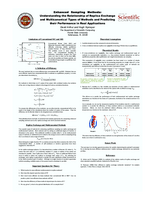
Name: David Arthur
Advisor: Hugh Nymeyer
Replica Exchange, also known as parallel tempering, is an extension to Monte Carlo that has found its way into many disciplines of scientific computing. Due to its ability to overcome local optima it is a popular choice as a sampling method for systems that have very rugged energy landscapes, such as explicit-solvent protein folding, n-state Potts model, and others. A general introduction to Replica Exchange is presented with results for a 1D four-replica simulation as well as a discussion of parallel implementation.
Computing Centriodal Voronoi Tessellations on the GPU
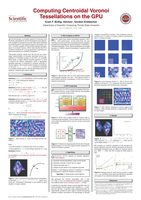
Name: Evan Bollig
Advisor: Gordon Erlebacher
In the last decade, commodity Graphics Processing Units (GPUs) specialized for 2D and 3D graphics have dramatically changed in purpose from purely video game hardware to something akin to their general purpose counterpart, the CPU. Currently capable of near teraflop speeds with gigabytes of on-board memory, GPUs have transformed from accessory hardware for a young generation to general purpose coprocessors for scientific computation. In this poster we present results from the first (to our knowledge) implementation to compute centroidal Voronoi tessellations of manifolds entirely on the GPU. To complete these tasks, a highly efficient flooding algorithm is used to produce the Voronoi tessellation, while a regularized sampling approach is employed to compute centroids of Voronoi regions. We consider simple surfaces (2-manifolds) of the form f(u, v) → (u, v, z(u, v)) partitioned according to Euclidean-based metrics, with the generating points updated by a deterministic Lloyd’s method.
Finite Element Methods for a Peridynamic Model of Mechanics
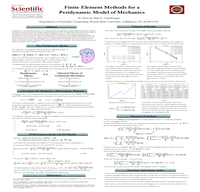
Name: Xi Chen
Advisor: Max Gunzburger
Peridynamics is a recently developed continuum model for solid mechanics that replaces the partial differential equations of classical continuum theories with integro-differential equations. We apply Finite Element Methods as well as Discontinuous Galerkin Methods to discretize the peridynamic model. Since the integro-differential equations remain valid in the presence of discontinuities such as cracks, it has the potential to model fracture and damage with great generality. We use piecewise constant and discontinuous piecewise linear basis constant and discontinuous piecewise linear basis functions in regions where discontinuities may appear and continuous piecewise linear basis functions in areas where the solutions are smooth and investigate how to combine these two methods. We are also interested in the choice of the horizon radius to implement the peridynamics model more accurately; cases when the radius is fixed as a constant or as a function of grid distance are tested. Some theoretical analysis, i.e., existence and uniqueness of the solution and error estimation, as well as numerical results for different cases are given.
MySQL Implementationof Protein Structures: SupSQL
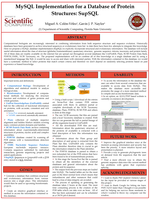
Name: Miguel Colon-Velez
Advisor: Gavin Naylor
Computational biologists are increasingly interested in combining information from both sequence structure and sequence evolution. Historically, databases have been generated to archive structural sequences or evolutionary trees, but to date there have been few attempts to integrate this knowledge. Here we propose a MySQL database implementation (SupSQL) to explicitly incorporate structural information with evolutionary one. The database will include useful information about the class of structure globular/transmembrane), quaternary structure, genomic sequence, introns, taxonomy, protein family, etc. All of this data is readily available on the internet but it is spread out throughout several databases like UniProtKB, Pfam, RCSB Protein Data Bank, PDBTM, EMBL, NCBI Taxonomy, etc. The proposed implementation will let us combine all of this knowledge in a single database and by using a standardized language like SQL it would be easy to access and share with interested parties. With the information contained in this database, we would have a systematic method to select proteins that match certain criteria and therefore we don’t depend on randomly selecting proteins based on past experience or biased knowledge.
Internal Elastic Fields and Dislocation Density Tensor in Deformed FCC Crystals: Computational Modeling and Experimental Investigation
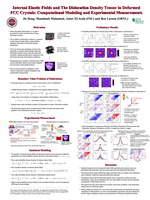
Name: Jie Deng, Mamdouh Mohamed
Advisor: Anter El-Azab
The strength of metals is determined by the ease with which dislocations (linear crystal defects) move and arrange themselves in the deforming metal. In general, a deforming metal contains a large number of dislocations the motion of which is strongly affected by the long-range internal stresses. Due to the discrete nature of dislocation in crystals, the statistical character of dislocation density and associated internal elastic field play an important role in the spontaneous formation of various dislocation patterns. The present study has been performed to understand the distribution and correlation of internal elastic fields. The internal stress, strain and lattice rotation fields in representative volume elements of crystals have been computed using an exact formulation of the elastic boundary value problem of dislocation fields, in conjunction with the method of dislocation dynamics simulation. The statistics of internal elastic fields has been analyzed in terms of probability distribution function and the pair correlation function, which are established by taking the ensemble average over generalized dislocation probability distribution functions. Since the elastic strain and lattice rotation fields are directly related to the lattice curvature and dislocation density tensor fields, we analyzed their spatial features and probability density functions as well. The results illustrate the importance of statistical analysis of internal fields, and the comparison of the simulation results with experimental data provides a direct way to evaluate the prediction of theoretical plasticity models.
Phase Field Framework for Modeling Microstructure Changes in Irradiated Materials
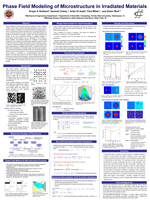
Name: Santosh Dubey, Srujan Rokkam
Advisor: Anter El-Azab
Reactor materials in nuclear power systems are subject to neutron irradiation conditions which results in intense point defect generation by virtue of atomic collision cascades. The diffusion and clustering of these point defects lead to a variety of microstructure evolution processes which can severely affect their in-service mechanical performance. We present a phase field framework for modeling microstructure of irradiated material. The model presented here focuses on the void microstructure evolution in irradiated materials, a technologically important problem which is responsible for void swelling of reactor materials. The traditional approach for modeling of void swelling considers the void nucleation and growth stages separately using point kinetic models which treat void nucleation and growth as uniform processes in space. In contrast, our phase field approach treats processes of void nucleation and growth simultaneously in a spatially resolved fashion. The defect fluxes and the defect density modulations are formulated using Cahn-Hilliard type description for the vacancy and interstitial concentration fields. The void growth dynamics is obtained in terms of the evolution of a non-conserved order parameter field, whose evolution is prescribed by a phenomenological Allen-Cahn type equation. The model also accounts for the effect of applied stress, cascade-induced and thermally-induced fluctuations, vacancy-interstitial recombination, and interaction of vacancies and interstitials with lattice sinks. Illustrative results of model capabilities are presented using the case of a pure metal as an example.
The Crab Nebula
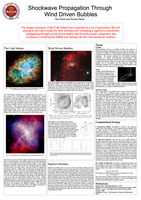
Name: Bert Green
Advisor: Tomasz Plewa
Reactor materials in nuclear power systems are subject to neutron irradiation conditions which results in intense point defect generation by virtue of atomic collision cascades. The diffusion and clustering of these point defects lead to a variety of microstructure evolution processes which can severely affect their in-service mechanical performance. We present a phase field framework for modeling microstructure of irradiated material. The model presented here focuses on the void microstructure evolution in irradiated materials, a technologically important problem which is responsible for void swelling of reactor materials. The traditional approach for modeling of void swelling considers the void nucleation and growth stages separately using point kinetic models which treat void nucleation and growth as uniform processes in space. In contrast, our phase field approach treats processes of void nucleation and growth simultaneously in a spatially resolved fashion. The defect fluxes and the defect density modulations are formulated using Cahn-Hilliard type description for the vacancy and interstitial concentration fields. The void growth dynamics is obtained in terms of the evolution of a non-conserved order parameter field, whose evolution is prescribed by a phenomenological Allen-Cahn type equation. The model also accounts for the effect of applied stress, cascade-induced and thermally-induced fluctuations, vacancy-interstitial recombination, and interaction of vacancies and interstitials with lattice sinks. Illustrative results of model capabilities are presented using the case of a pure metal as an example.
Evolution of Non-spherical Core Collapse Supernovae Toward Homology
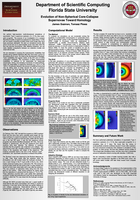
Name: Jaime Guzman
Advisor: Tomasz Plewa
We perform high-resolution multi-dimensional simulations of asymmetric Type II supernova explosion of a 15 M blue supergiant progenitor. The purpose of our investigation is to compare theoretical models of supernova explosions to observations. To this aim we require computing evolution times much longer than have been previously attempted. We start our simulations shortly after shock revival and run to approximately seven days later when the flow has become homologous. After attaining homologously expanding models we can make detailed comparisons between our explosion models and observational data. We are also interested in studying the hydrodynamic instabilities that develop along material interfaces after they have been overrun by the passing shock wave. We observe the development of Rayleigh-Taylor instabilities that appear at the Si/O and (C+O)/He composition interfaces. The occurrence of these hydrodynamic instabilities is believed to be responsible for large-scale anisotropies, mixing, and clumping of products of nucleosynthesis, which are observable features that have been found to be common traits of supernova remnants (e.g. Cas A or SN 1987A). Of particular interest is the amount of additional mixing that may be taking place at times beyond the reach of previous computations (six hours after the shock revival). Up to that point, our models are largely consistent with the results obtained by Kifonidis et al. (2006), and all major observational features of SN 1987A.
Thermal Conduction and the Rayleigh-Taylor Instability
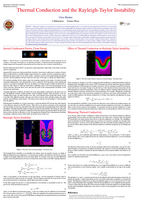
Name: Chris Harden
Advisor: Tomasz Plewa
Hydrodynamic instabilities are of critical importance in several basic physics and engineering applications. Here we are concerned with inertial connement fusion (ICF). The ICF is one of the potential solutions to solve growing energy demands of the world and, at the same time, thanks to being essentially pollution-free, help taming some negative trends observed in Earth’s natural environment (global warming). In the context of ICF technology, hydrodynamic instabilities place fundamental limitations on the experimental design parameters that affect capsule ignition. Thus, understanding these instabilities is crucial to improving the performance and energy gains achievable by ICF. The hydrodynamic instability of interest in this work is the Rayleigh-Taylor (RT) instability since this is the dominant instability during the ICF capsule compression and leads to shell disruption and overall target performance degradation. Much work has been done on understanding RT instabilities in pure hydrodynamic experiments and in simulations. In ICF however there are other types of physics besides hydrodynamics at work and it is well known that pure hydro simulations fail to account for the way in which RT instabilities form and propagate in actual ICF experiments. One type of physics known to be present in ICF experiments is thermal conduction. The focus of this work is to investigate the effects of thermal conduction on RT instabilities. Although general physical properties of plasma in that regime are generally well-known, we lack information about more specific characteristics. One such property is efficiency of the thermal conduction, which is expressed by a coefficient of thermal conductivity. Furthermore, the conditions relevant to ICF can be obtained only in the course of unique ICF-like (high-energy density) experiments. Such experiments are very expensive making it a challenge to be able to accurately measure the non-constant thermal conductivity coefficient accurately. In this work we explore a technique for measuring this coefficient with the goal of understanding the effect of thermal conduction on RT instabilities and validating our simulation codes against ICF experimental data.
Stress-driven Surface Instabilities in Solids with Diffusing Charged Defects
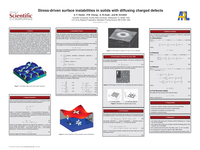
Name: Steve Henke
Advisor: Anter El-Azab
Stress-driven rearrangement instability (SDRI) theory postulates that diffusion in stressed solids can lead to surface morphological instability, an effect that is currently believed by many physicists to be real and important for elevated-temperature deposition or annealing of thin films. Both atomic surface diffusion and bulk diffusion of point defects contribute to the instabilities. The stress-driven diffusion of mobile oxygen vacancies in the bulk is especially important in ferroic perovskite films (e.g., Barium Strontium Titanate), which have desirable optical and electric properties for device and sensor applications, and often require well-controlled surfaces and interfaces. We present a continuum reformulation of the SDRI theory that includes the coupled electro-elastic diffusion of oxygen vacancies and introduce a 3D finite-element scheme to solve the equations for film surface evolution. We also explore the stability of the film boundary due to perturbations and attempt to characterize the incipient instabilities in terms of the model parameters.
Effect of Grids on North Atlantic Overflow Simulations
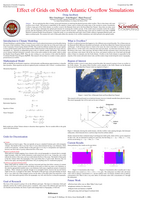
Name: Doug Jacobsen
Advisor: Max Gunzburger
We are exploring the effect of using various grid structures on resolving the physical process called overflow. This is when dense cold water overflows from a basin. This process is responsible for the majority of dense water in oceans and creates many of the currents in oceans. In particular, it affects a large part of the North Atlantic, as overflow occurs in the Denmark Strait and in the Faroe Bank Sea Channel. Since there are many ocean models, we are trying to determine the optimal grid structure for resolving the overflow process. If the model cannot accurately resolve the overflow process, then the simulation will be incorrect as currents in oceans will be incorrect. Among the many ocean and ice models in use today is HyPOP (Hybrid-Coordinate Parallel Ocean Program). Using this model, we are testing three grid types, fixed Z Grids, arbitrary Lagrangian-Eulerian grids, and sigma-coordinate grids. We examine how each of these grids affects the outcome of our overflow simulations, and which grid gives the optimal results.
Classification and Prediction Markets
Name: Nathan Lay
Advisors: Anke Meyer-Baese & Adrian Barbu
In classification, it is often desirable to combine a set of classifiers to improve overall accuracy. This notion has produced robust classifiers such as Random Forest and various Boosting techniques. Here we present an alternative way to combine classifiers using ideas from prediction markets. Prediction markets have revealed themselves as accurate predicters of future events. Additionally, we present a means to specialize a prediction market classifier to improve overall accuracy of classification.
A numerical investigation on asymptotic features of model selection criteria
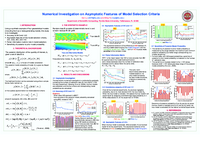
Name: Dan Lu
Advisor: Ming Ye
When conducting model averaging for multiple hydrologic models, the model selection criteria, AIC, AICc, BIC, and KIC, have been widely used for calculating model probabilities or averaging weights. We numerically investigated the asymptotic features of these criteria based on a synthetic example of four geostatistical models (including the true or data-generating model). The investigation demonstrates that, although KIC asymptotically reduces to BIC, using MC results as reference, KIC is more accurate than BIC for approximating the model likelihood function and for calculating model probabilities. The difference between BIC and KIC is mainly caused by the log determinant of the Fisher information matrix, specific to KIC. The term discriminates alternative models based on not only model complexity but also model structures, a feature not shared by other criteria. The asymptotic analysis also reveals that, for both AICc- and KIC-based probabilities, sensitivity of posterior to prior model probability is irrelevant to the number of calibration data.
Reduction of Electronic Structure Problems of Density Functional Theory
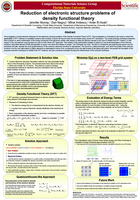
Name: Jennifer Murray
Advisor: Anter El-Azab
We investigate a model reduction technique for the electronic structure problem of the Density Functional Theory (DFT). This investigation is motivated by the need to extend the applicability of DFT methods to crystalline systems with numbers of atoms far beyond what can be treated using current DFT techniques. The model reduction technique presented here is based on direct minimization of the energy functional of the electronic system with respect to either the electron density in the case of Orbital-Free DFT method, or with respect to the one-electron wave functions in the case of Kohn-Sham DFT approach. This solution of the minimization problem is aided by a two-level interpolation of the unknown functions using finite element (FEM) discretization of space over which the solution is sought. Two FEM grids are used. The first is a subatomic grid spanning the space over the individual unit cells, wherein the local spatial behavior of the unknown electronic functions is represented. The second is a lattice-level grid, over which the profile of the unknown functions over the unit cells interior to lattice elements is interpolated in terms of its counterparts at the unit cells located at the lattice grid points. We present the formalism of the proposed reduction technique for both Orbital-Free and Kohn-Sham type DFT methods, and give numerical examples showing the effectiveness of the reduction technique for the Orbital-Free DFT method.
Integration and the Structured Coalescent
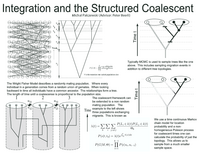
Name: Michal Palczewski
Advisor: Peter Beerli
For many biological investigation groups of individuals are sampled from different locations. From these samples genetic data is extracted. Of interest are the population sizes of the sampled species at different locations and the migratory patterns among them. In the past this inference has been done by using MCMC to sample trees with migratory events. What I propose is a new method that reduces the dimensionality of the sampled tree space by removing migration events. Instead, I propose an algorithm to integrate over all possible migration events that are possible to calculate the probability of a tree. This reduces the problem to something more manageable and is often seen in phylogenetic studies, a simple rooted clock like bifurcating tree. When the data is precise this allows for very quick estimation of population genetic parameters.
Toolkits for Automatic Web Service and GUI Generation
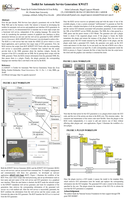
Name: Yenan Qu
Advisor: Gordon Erlebacher
Over the past decade, Web Services have played a prominent role in the Internet area and in the business world. Our interest is focused on developing the tool-kits for automatic web service and graphical user interface (GUI) generation. In previous work, we demonstrated how to translate input scripts into a functional web service, independent of the scripting language. We extend this work by considering the automatic creation of graphical user interfaces to allow interaction between an end user and the web service generated by KSG (Kwatt Service Generator). KGG (Kwatt GUI Generator) was developed to achieve this. The KGG is a web service that runs inside the Axis2 server, and it performs four major steps of GUI generation. First, the KGG receives the scripts from KGT (Kwatt GUI Tools) after the corresponding web service generated successfully. Comment lines inserted into the scripts provide hints to the XML generator about the interface widgets. Second, the structure of the GUI is encoded into an XML file by parsing those scripts with the XML generator. Third, the KGG extracts information from the generated XML file, then passes them to a plugin. Finally, the plugin generates the corresponding language user interface that is sent back to the user by the KGG.
Peridynamics as an Upscaling of Molecular Dynamics
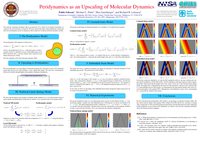
Name: Pablo Seleson
Advisor: Max Gunzburger
Peridynamics is a reformulation of continuum mechanics based on integral equations. It is a non-local model, accounting for the effects of long-range forces. Correspondingly, classical molecular dynamics is also a nonlocal model. Peridynamics and molecular dynamics have similar discrete computational structures, as peridynamics computes the force on a particle by summing the forces from surrounding particles, similar to molecular dynamics. We explore how the peridynamics model can be cast as an upscaling of molecular dynamics. Specifically, we address the extent to which the solutions of molecular dynamics simulations can be recovered by peridynamics. Analytical and numerical comparison between molecular dynamics and peridynamics is presented.
Optimization Methods for Parabolized Navier-Stokes Flowfield Reconstruction
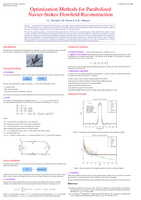
Name: Jeff Steward
Advisor: I. Michael Navon
A parabolized Navier-Stokes (PNS) simulation of a jet engine is used to generate downstream temperature, density, and velocity values in 2-D. The PNS equations are a simplification of the full Navier-Stokes that conflate the time and marching coordinate. Downstream temperature, density and velocity readings are sampled, from which the upfield parameters are to be reconstructed. We solve this problem by defining a cost functional that describes the lack-of-fit between the model parameters and the upfield initial conditions. Using a continuous adjoint of the PNS equations, the gradient of the cost function with respect to the initial conditions is obtained. From this point, we use the gradient and an initial guess as input to several optimization algorithms, including: three versions of the nonlinear conjugate-gradient (CG) method, three quasi-Newton adaptations, a new hybrid CG/quasi-Newton algorithm, and a non-smooth optimizer n1cv2. Based on our tests for a variety of different Reynolds numbers, the non-smooth n1cv2 method proved superior at reconstructing the initial conditions by a full order of magnitude but at a higher computational cost. Nonsmooth optimization methods for inverse problems of this nature hold promise for increased accuracy.
An Edge-Weighted Centroidal Voroni Tessellation Model for Image Segmentation
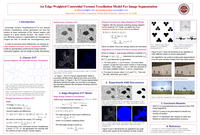
Name: Jie Wang
Advisor: Xiaoqiang Wang
Centroidal Voronoi Tessellations (CVTs) are special Voronoi tessellations whose generators are also the centers of mass (centroids) of the Voronoi regions with respect to a given density function and CVT-based methodologies have been proven to be very useful in many diverse applications in science and engineering. In the context of image processing and its simplest form, CVT-based algorithms reduce to the well-known k-means clustering and are easy to implement. The CVT-based segmentation has been applied successfully to images with homogeneous regions, each having a distinct centroid, i.e., a mean intensity value of the associated CVT cluster. But it is not easy to control the accuracy of the segmentations generated by classic CVT algorithm especially for the inhomogeneous images. We develop an edge-weighted Centroidal Voronoi Tessellation (EWCVT) model for image segmentation and propose some efficient algorithms for its construction. Our EWCVT model can overcome some deficiencies possessed by the basic CVT model; in particular, the new model combines the image intensity information together with the length of cluster boundaries, and can handle very sophisticated situations. In order to meet different accuracy requirements of various applications, we can simply adjust the weight of the image intensity information and the boundary length to produce different segmentations. We demonstrate through extensive examples the efficiency, effectiveness, robustness, and flexibility of the proposed method.
Spherical Centroidal Voronoi Tessellations: Unstructured Meshes For Ocean Applications
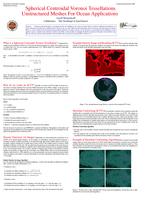
Name: Geoff Womeldorff
Advisors: Max Gunzburger & Janet Peterson
In the past and increasingly so towards the present, the modeling of our oceans is of great import. In order to facilitate this simulation, we wish to discretize the sphere in an optimal manner. That is to say, we wish to place the most grid points where we have the most information to capture. Here, we wish to support both local refinement and global refinement. In order to do this, we use the theory of centroidal Voronoi tessellations on the sphere to give us a regular mesh, and then we add to it the ability to refine locally by managing the density of generators through a custom density map. We also take into account an approximation of the shoreline and we use this to force grid cells to conform to it.

